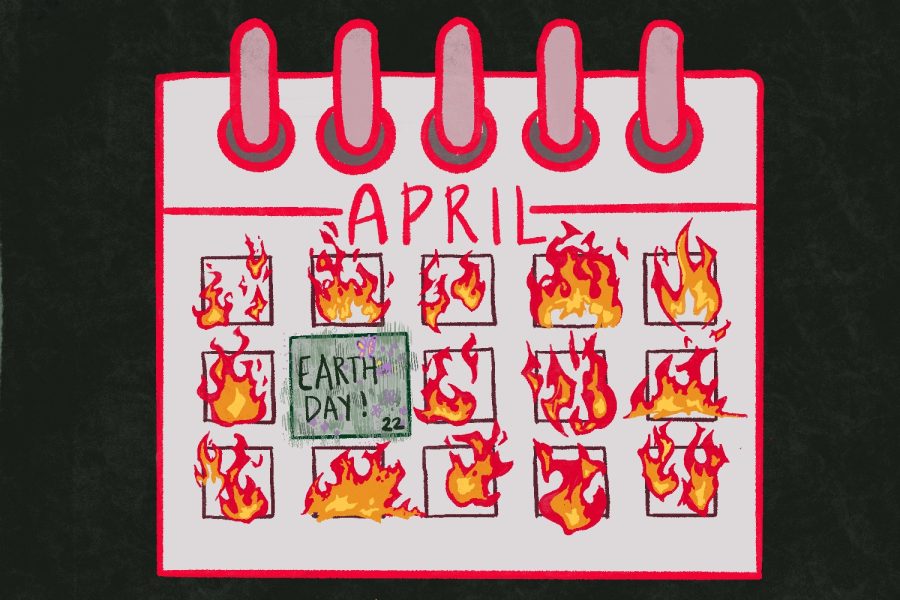Every Earth Day, the world shows an annual dedication to the planet, but these actions must be sustained to combat the increasing impacts of the climate crisis effectively.
The modern environmental movement was initiated on April 22, 1970, and is celebrated yearly to amplify ecological consciousness and bring climate change to the headlines. On the first Earth Day, the United States passed numerous environmental laws. More recently, the Paris Climate Agreement was signed on Earth Day in 2016. Yet, climate change has continued to worsen in the past 40 years.
“In recent times, people have been treating Earth Day as an occasion during which they can take action for one day to feel better about themselves,” said Swaraa Joshi, a Youth vs. Apocalypse member and a Youth Climate Ambassador alumni.
These actions can include spring cleaning, donating to thrift stores, park and beach clean-ups, disposing of electronics, and planting trees.
“Recycling and donating a couple of shirts for one day is not enough. The problem with this mentality is that people don’t make them into habits. And even if they become habits, these Earth Day actions don’t target the root causes of climate change and those affected by it,” Joshi said.
Many cities take on clean-up projects for the occasion. In San Francisco, Earth Day’s main events include cleaning national recreation areas. Though local clean-ups are beneficial, environmental justice activists are working to refocus Earth Day around those in dire need of help due to direct climate change impacts.
“Across the Bay Area, race, income, pollution, and health issues are strongly connected because our system treats certain communities as disposable. Earth Day should unite these issues and bring attention to them,” said Carolyn Norr, a co-founder of Youth vs. Apocalypse.
Marginalized communities experience the harshest impacts of climate change due to their proximity to landfills and industrial plants. A 2018 report from the Environmental Protection Agency (EPA) confirmed that people of color are increasingly likely to live near polluters.
Due to environmental racism, the increased mortality rates from pollution tend to be overlooked in these often low-income communities.
Third-world countries are taken advantage of because of these inequalities, largely by fast fashion companies who are growing in popularity.
The toxic dyes that make the cheap production of vibrant, fast fashion garments are dumped into oceans and nearby waterways, polluting the drinking water of impoverished people in China, Vietnam, Bangladesh, and India.
Alongside other leading industries, these fast fashion companies also produce carbon dioxide by burning fossil fuels.
As carbon dioxide levels continue to rise, countries including Kiribati, Marshal, Tuvalu, and the Maldive Islands are forced to deal with rising sea levels. According to the National Resources Defense Council, the expansion of seawater and melting glaciers threaten these islands with the possibility of disappearing in the coming decades.
Supporting industries that contribute heavily to water pollution, third-world country exploitation, and carbon air pollution push environmentally destructive practices.
“There are many ways people can support the environment: what they buy, the food they eat, their transportation, and more. People can choose to make lifestyle changes, but what’s most important is that they stick with them,” said Matt Burgos, Carlmont Green Team’s co-president.
To recenter the narrative of Earth Day, alongside promoting smaller actions, climate activists are demanding changes from their legislatures.
The Bay Area-based organization Youth vs. Apocalypse directly combats environmental racism by amplifying the diverse voices of youth in the fight for environmental justice. In their upcoming People’s Earth Day Protest, they plan to demand San Francisco officials recognize the struggles of Black, Indigenous, and poor communities.
The group takes action year-round through multiple campaigns and initiatives, putting pressure on corporate polluters and local boards. Their successes include the shut-down of a proposed coal terminal in West Oakland, the expansion of the local Green New Deal in the East Bay, stopping nuclear power in the East Bay, and building statewide support for the California State Teachers Retirement System (CalSTRS) divestment.
Organizations like Youth vs. Apocalypse reflect that environmental and political success cannot be achieved by only acting out on one day of the year.
“Earth Day isn’t about convenient solutions; it’s about recognizing the heavily impacted people and places and doing anything possible to help,” Joshi said.






















